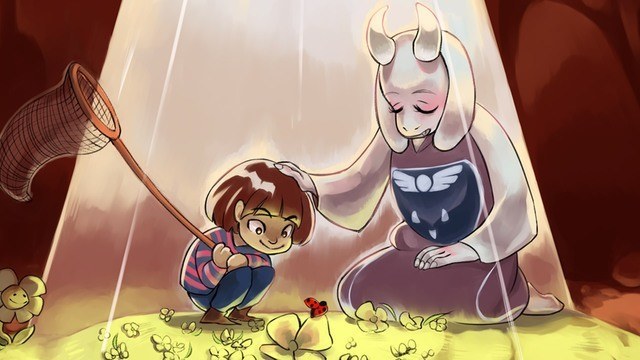With 250,000 sales in the weeks since its release, near universal praise, and at least one of your friends becoming a super-annoying evangelist for the game, it’s safe to say that Undertale has been a raging success.
More than a little of that is due to how the game has something for pretty much everybody to identify with — all couched in a narrative with feminist elements, strong LGBT representation, and other progressive values. Its exploration of archetypal characters and complex themes, and its willingness to engage with the player as an equal are certainly part of this. So too is its excellent soundtrack and novel fusion of genres.
But, ultimately, the open-minded attitude is what resonates with gamers and shows that, as community, we’re ready for more.
If you haven’t beaten Undertale yet and wish to avoid spoilers, turn back now…
Romance and variety
Outside of BioWare titles, it’s difficult to come up with examples of a mainstream game with a cast including multiple queer characters; rarer still are queer characters who have identifying characteristics beyond their sexuality. Undertale, however, features at least five characters who fall under the LGBT umbrella. Three of these characters have major roles within the game, serving as allies of the protagonist as well as major bosses, depending on the choices that the player makes.
The Royal Guards, a miniboss encounter in the Hotlands section of the game, are two male guards who can be encouraged to go on a date instead of attacking the main character. Within the game’s writing, this is not treated in a special way at all — and this normalization of a queer relationship makes it special. Their relationship, such as it is, is not depicted any differently than the heterosexual relationships present in the game. As they are ultimately very minor characters, though, their characterization is limited.
One of the major relationships (queer or otherwise) in the game is seen during the Pacifist route. Alphys, a character who assists the player indirectly, is a bisexual character who harbors crushes on both King Asgore and Undyne. While the former is unrequited, the latter is a mutual crush that can be acted on. Completing a certain objective to befriend Undyne allows the player to begin a sequence of optional events to bring the two together. As with the Royal Guards, the fact that both characters are the same gender isn’t emphasized. The game instead focuses on their mutual admiration — for anime as well as each other.
Both characters have roles in Undertale outside of their relationship, and interactions with other characters that do not reference it in any way.
Undyne is first presented as the mentor of another character, Papyrus. She is depicted as a menacing figure in armor who hunts the protagonist. Alphys works for Asgore as his Royal Scientist and created a robot body for Mettaton, another LGBT character, to inhabit.
Speaking of Mettaton…
Mettaton can be read as a trans character, according to one convincing fan theory. Originally a ghost — judging by Napstablook, ghosts do not appear to have a particular gender — Mettaton inhabited a house that is designed to be perceived as typically feminine. Diary entries there reveal that Mettaton yearned for a corporeal body.
After receiving one, Mettaton is regarded and refers to themselves as male. During his boss fight, Mettaton reveals that he has been waiting excitedly for some time to show off his masculine form. All of this combined makes a strong case for him being trans, though he is never explicitly referred to as such within the game.
Strong and strongly-written characters
Through Alphys and Undyne, Undertale passes the Bechdel Test with ease. On its own, this does not necessarily indicate a work with feminist themes, but alongside well-written female characters it is significant — and the memorable characterization of both alongside Undertale’s generally excellent writing makes them so.
Both of these characters also break out of traditional gender roles and freely pursue their goals without comment or opposition based on their gender.
Undertale’s Undyne
A work with feminist elements doesn’t necessarily have to include or be entirely populated by mold-breaking characters like Alphys and Undyne. Toriel, whom the protagonist meets near the beginning of the game, neither passes the Bechdel Test in any substantial manner nor steps far outside of a traditional nurturing role. Nonetheless, she is another excellent example of a well-written female character that showcases Undertale’s progressive values.
While Toriel only appears in a small percentage of the game, her impact is felt keenly throughout. She is shown to be a formidable fire magic user and was formerly queen of the underground. Some neutral endings of Undertale see her resume this leadership position and successfully rule alone. The choices she makes within the game aren’t restricted or informed by her gender, but instead spring from her personality. In this way, Undertale nimbly avoids brushing with oft-criticised choice feminism.
Conclusion
All of these characters and elements come together to enrich an already fantastic game. Their pivotal roles within Undertale’s story and strong characterization make each a positive, nuanced representation of queer characters and relationships. Undertale wears its progressive heart on its sleeve through this, and its popularity shows that gamers are more than ready for more games like this.









Published: Nov 5, 2015 06:51 am